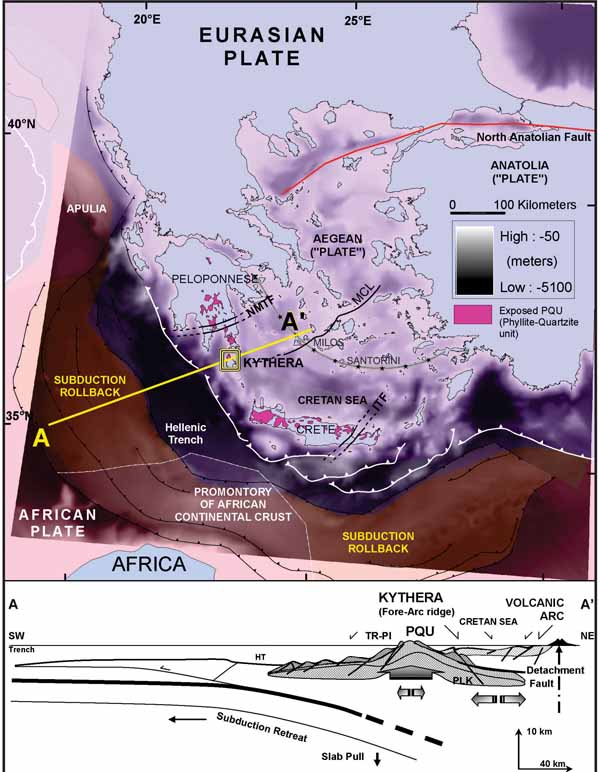Geological Framework
The Late Miocene-Recent extensional opening of the Cretan sea and associated exhumation of high pressure (HP) metamorphic rocks is the most recent major tectonic event that contributed to construction of the Peloponnese-Cretan ridge. Extension was accompanied by Late Pliocene to Recent volcanism along the Hellenic volcanic arc in the Sousaki, Methana, Milos, Santorini, Nisyros, and Kos areas. In addition, Late Miocene granitoids intruded the exhumed Middle-Late Miocene HP-rocks in the South Aegean.
The protolith of the metamorphic Phyllite-Quartzite unit (PQU) is interpreted to be a mid-Carboniferous to Triassic rift sequence (Krahl et al. 1983) that formed during opening of a southern branch of the Neotethyan ocean (Pe-Piper 1982, Seidel et al., 1982; Robertson and Dixon, 1984). However, a granitic orthogneiss emplaced within the PQU at 323 ±3 Ma (U-Pb on zircon; Seidel et al., 2006; Xypolias et al., 2006) raises a question about the interpreted age of the rift sequence. The protolith and depositional age of the PQU in the Hellenic forearc ridge and within HP-rocks exposed in the Cyclades, including on Milos and Santorini Islands, as well as exposures in Attiki remain un-constrained. The HP-LT metamorphic sequences of the Phyllite-Quartzite unit (PQU) on Crete are likely Late Palaeozoic based on Tethyan deep water fossils (Krahl et al., 1983; 1986).
There are very few published U/Pb ages from detrital or inherited zircons from the metamorphic basement of the entire Hellenic forearc and volcanic arc. Zircons from a Carboniferous orthogneiss that is intercalated with the metasedimentary rocks in the PQU from Kythera give Late Archaen-Early Proterozoic ages suggesting derivation from ancient crust in the basement of the External Hellenides (Xypolias et al., 2006). Pan-African, Variscan, and younger zircon ages have been reported from orthogneisses from the Chamezi and Myrsini crystalline complexes in Eastern Crete (Romano et al., 2004). Late Archaean-Early Proterozoic U-Pb ages have been reported for detrital zircons from metasediments from central Crete (Galinos beds; Kock et al., 2007), the Menderes massif (Kroner & Sengor, 1990) and the Cycladic crystalline massif (Keay & Lister, 2002).
Along the entire Cretan-Peloponnese ridge metamorphic rocks including gneisses or blueschist rocks frequently occur as lenses within the phyllites. These may be part of the PQU unit or an exotic unit tectonically intercalated in the PQU. Lenses of metamorphic rocks in the PQU rocks share a similar Cenozoic tectonothermal history (e.g., Marsellos et al., 2010), but it is unclear if they were together prior to Cenozoic time due to the lack of sufficient U-Pb zircon data.
Figure 1. Tectonic setting of the South Aegean arc.

Bathymetry shown by a semi-transparent DEM layer; a cross section line A - A' along a NE-SW line through the Kythera strait.